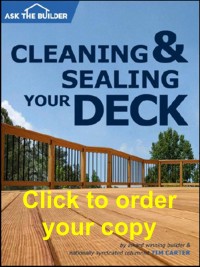Concrete Pier Construction Tips
DEAR TIM: My upcoming deck project requires concrete support piers. I've never done this before and have many questions. Do I have several options? How do I make sure the piers are in the correct locations? What type of concrete pier foundation would you install if you were me? Can you share some best practices so I don't have a failure down the road? Nancy W., Greenville, SC
DEAR NANCY: I can see why you've got questions if you've never worked with concrete piers before. You do have options galore, and what you end up doing is primarily a function of the tools at your disposal and the amount of cash you have.

This concrete pier is supporting several tons of weight. PHOTO CREDIT: Tim Carter
You can discover the frost depth in your area by contacting your local building department. You'll be going there anyway to get a permit for this project as decks need to be inspected so they are safe. The local building inspector will probably want to check the soil to ensure it's strong enough. This means that you have to dig the hole for the pier to the required depth, and then have the inspector come out and look at it before you proceed with any more work.
As for your options, you can use any number of plastic or dense cardboard forms or tubes that will allow you to pour your own concrete pier. You can also purchase precast concrete deck piers that would be delivered to your home. The only trouble with these piers is that you need a backhoe to move them and lift them into place. The precast piers are very competitively priced when you consider how much it will cost you to buy the forms and possibly bring in a truck with all the concrete you'll need for all the piers.
You can also use concrete block to build your own piers, but this requires you to pour a concrete footing at the bottom of the hole for the block to rest on. You then have to fill the cores of the concrete block with steel rods and a concrete mix to make them solid. It's a lot of work, but it is a viable option. You also need to be somewhat skilled to lay concrete block level and plumb.
If the deck you're building is a simple square or rectangle and it's not too far off the ground, I've found that it's best to construct the actual outline of the deck. I would then use simple wood posts to temporarily support this box in the air.
Once you ensure it's the right size, it's level, and it's square, you install temporary diagonal braces at the corners to keep the box square. You can now drop plumb bobs or use a laser tool that project to the ground the exact position of where your deck posts will be. This allows you to precisely position each pier so the deck posts are centered on the exposed pier.
I would probably install concrete piers that I pour myself. I've used the traditional round dense cardboard tube forms with great success. There are new plastic forms that also work well, and I especially like the ones that have the funnel-shaped base that creates its own footer when you pour the wet concrete into the form. This special base has the shape of a bell.
As for best practices, I feel you need to make sure the bottom of the pier is wider than the top. This shape really helps prevent any frost heave from lifting the pier. If you use the traditional round tube that has the same shape top and bottom, it's possible for the frozen ground to grab onto the pier at the top and actually lift it from the ground as the frozen soil moves up. This is not common, but it can happen.
To prevent lift, I'll typically pour a concrete footer that's at least a foot wider in diameter than the pier. I place bent concrete steel rods in this footer that extend up into the tube. This way, once the pier is poured, it's connected to the large disc of concrete that makes up the footer. If the frost tries to lift the pier, it has to bring the footer with it. Because of its large shape, it provides lots of resistance.
Be sure you install steel reinforcing in all poured concrete piers. The steel vastly increases the tensile strength of the concrete. Place the vertical steel bars so they will not be in the way should you have to drill into the concrete pier to install anchors for a metal post base.
I would caution you to not put in anchor bolts in the concrete pier unless you have a foolproof method to ensure they are in the exact spot and the height of the pier is perfect. You typically don't have much wiggle room with anchor bolts once the concrete is hard.
Be sure the forms you use for concrete piers are braced well. The last thing you want to happen is for them to move as you shovel concrete into them. Triple check all your locations and the height to which you'll pour to make sure all is right. Once the concrete hardens, you can't move it easily.
Column 896

3 Responses to Concrete Pier Construction Tips